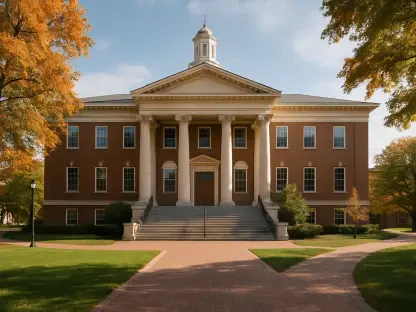In a striking and polarizing decision, the U.S. Department of Education under the Trump administration has chosen to redirect $350 million in congressionally approved grants away from minority-serving institutions (MSIs), sparking intense debate across the educational landscape. These institutions, which include Historically Black Colleges and Universities (HBCUs), Hispanic-serving institutions, and other colleges dedicated to underrepresented groups, enroll millions of students who often face significant socioeconomic barriers. Announced by Education Secretary Linda McMahon, this policy shift targets discretionary funding for the current fiscal year, raising profound questions about the federal government’s commitment to educational equity. As the nation grapples with systemic disparities in higher education, this move has ignited fierce discussions about the balance between legal principles and the practical needs of vulnerable student populations, setting the stage for a deeper examination of diversity and inclusion in federally supported programs.
Ripple Effects on Educational Equity
The redirection of $350 million in grants impacts approximately 800 MSIs, which collectively serve around 5 million students, many of whom are first-generation or from low-income backgrounds. These schools, ranging from Alaska Native and Native Hawaiian-serving institutions to Asian American and Native American Pacific Islander-serving colleges, have long been instrumental in bridging educational gaps. Federal funding often supports critical resources like scholarships, tutoring programs, and infrastructure improvements, which are essential for student retention and graduation. Without this financial backing, many institutions may struggle to maintain their programs, potentially leading to reduced enrollment or even closures in some cases. The cascading effect could limit access to higher education for underrepresented groups, undermining decades of progress toward leveling the playing field in academia.
Beyond immediate financial strain, the policy shift poses a broader threat to the mission of MSIs, which were established to address historical inequities in education. These institutions often serve as cultural and community hubs, fostering environments where students of color can thrive academically and socially. The loss of funding could diminish their capacity to offer specialized support services, such as mentorship programs or career counseling, which are vital for students navigating systemic challenges. Additionally, the cuts may deter prospective students who rely on financial aid, further narrowing pathways to economic mobility. As these colleges face an uncertain future, the impact reverberates through communities that depend on them as engines of opportunity, highlighting the stakes of federal funding decisions in shaping educational landscapes.
Legal Grounds and Policy Motivations
At the core of the Trump administration’s decision lies a legal argument rooted in constitutional interpretation, with officials citing a recent U.S. Justice Department opinion that labels race-based federal funding as unconstitutional. Supported by a memo from Solicitor General D. John Sauer and referencing the Supreme Court’s 2023 ruling against affirmative action in admissions, the administration contends that allocating funds based on the racial composition of student bodies violates the principle of equal protection under the law. This stance reflects a broader ideological push to dismantle diversity, equity, and inclusion (DEI) initiatives across federal programs, framing such efforts as inherently discriminatory. The policy, as articulated by Education Secretary McMahon, prioritizes a colorblind approach, asserting that federal resources must be distributed without regard to racial or ethnic criteria.
This legal justification, however, extends beyond courtroom arguments into a larger political narrative championed by the administration. The redirection of funds aligns with ongoing efforts to challenge programs perceived as prioritizing diversity over merit, a perspective that has gained traction among certain conservative circles. By invoking Supreme Court precedents and Justice Department guidance, the policy seeks to establish a framework where federal support is decoupled from historical missions of racial redress. Critics argue this interpretation overlooks the unique role of MSIs in addressing systemic barriers, but proponents maintain that equal treatment under the law must supersede race-conscious allocations. This clash of principles underscores a pivotal moment in the national discourse on how education funding should reflect societal values and legal standards.
Fierce Opposition from Stakeholders
Democratic lawmakers and advocacy groups have mounted a robust defense of MSIs, condemning the funding cut as a direct assault on educational equity and opportunity for students of color. Rep. Bobby Scott (D-Va.), a prominent voice in education policy, has emphasized the indispensable role these institutions play in fostering economic mobility, particularly for under-resourced and first-generation learners. Advocacy organizations, such as the Hispanic Association of Colleges and Universities, argue that the grants benefit entire campuses, not just specific racial groups, by funding programs in high-demand fields like science, technology, engineering, and math (STEM). The backlash reflects a deep concern that defunding MSIs will exacerbate existing disparities, rolling back progress made in creating inclusive academic environments over recent decades.
The opposition also challenges the administration’s framing of MSIs as discriminatory, pointing out that many of these schools were founded with specific historical missions rather than strict racial quotas. For instance, HBCUs and tribal colleges emerged to serve communities excluded from mainstream education due to systemic racism and segregation. Critics contend that slashing their funding ignores this context, effectively punishing institutions for addressing inequities they did not create. There is also growing speculation about potential legal challenges to the policy, as stakeholders explore avenues to protect federal support for MSIs. This widespread dissent highlights a fundamental disagreement over the role of race in education policy, setting the stage for prolonged contention in legislative and public arenas.
Questions Surrounding Fund Reallocation
A significant point of contention in this policy shift is the ambiguity surrounding the destination of the diverted $350 million. The Department of Education has provided scant details, stating only that the funds will be reallocated to programs that avoid “discriminatory racial and ethnic quotas” and align with administration priorities. This lack of transparency has fueled skepticism among educators, lawmakers, and advocacy groups, who question whether the redirected resources will address educational needs or be funneled into unrelated initiatives. Without a clear plan, there is a risk that the funds may not benefit students or institutions in meaningful ways, intensifying concerns about the motives behind the decision.
Moreover, the uncertainty over reallocation raises broader questions about the administration’s vision for higher education funding. Stakeholders worry that the policy may reflect ideological goals rather than a pragmatic approach to supporting student success. The absence of specifics about alternative programs or beneficiaries creates a vacuum of trust, as communities affected by the cuts grapple with diminished resources. This opacity not only complicates efforts to assess the policy’s impact but also amplifies fears that the redirection could undermine the federal government’s role in promoting equitable access to education. As debates continue, clarity on the fate of these funds remains a critical demand from those advocating for transparency and accountability.
Path Forward Amid Controversy
Looking back, the decision to divert $350 million from minority-serving institutions under the Trump administration marked a contentious chapter in the ongoing struggle for educational equity. It exposed deep divisions over how federal resources should address historical disparities, with significant implications for millions of students and hundreds of colleges. Reflecting on this moment, the need for robust dialogue between policymakers, educators, and communities became evident as a way to navigate these complex issues. Moving forward, a potential path could involve targeted advocacy to restore funding through legislative action, alongside efforts to develop alternative support mechanisms for MSIs. Additionally, fostering public awareness about the value of these institutions might help build broader support for their missions. As the landscape of higher education continues to evolve, finding sustainable solutions to balance legal principles with the practical needs of underrepresented students remains an urgent priority for shaping a more inclusive future.









